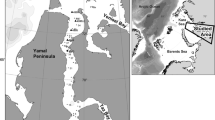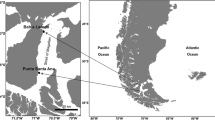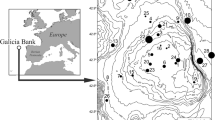Abstract
Composition, abundance and stratification of soft-bottom macrobenthos were studied at three selected sites on the Ross Sea shelf (Antarctica) with different geomorphology and sedimentation regimes. Sites A (southwest Ross Sea, 810 m depth) and B (Joides basin, 580 m depth) were characterized by biogenic mud and clay sediments, whereas site C (Mawson bank, 450 m depth) featured sandy sediments mixed with a conspicuous biogenic component characterized by shells and tests of calcareous invertebrates (mainly barnacles of the genus Bathylasma). The macrofauna of sites A and B was mainly composed of infaunal polychaetes and bivalves. The assemblages comprised both surface and sub-surface deposit feeders, including some conveyor-belt polychaetes (Maldanidae and Capitellidae) that are responsible for high sediment mixing and bioturbation. The macrobenthos of site C was dominated by crustaceans, polychaetes and echinoderms (ophiuroids), and mainly by filter feeders and epifaunal or interstitial forms. Abundances were higher (up to 1040 ind. m−2) at site B than at sites A and C (430 and 516 ind. m−2, respectively). At sites A and B the benthos was mainly concentrated in the upper 5 cm of the sediment, and abundances declined sharply in the deeper sediment layers. These results indicate a high degree of consistency between sediment features and benthic community structure, which are both strongly related to local hydrography and bottom dynamics. Sites A and B represent areas where the organic input to the seafloor by vertical sedimentation from the upper water column is high. Site C, however, is characterized by high sediment instability and food particles advecting mainly horizontally. The community is more physically controlled by unpredictable, and probably frequent, disturbance events (e.g., bottom turbid currents, sediment reworking and displacement). Individuals were relatively small, indicating that probably they are not able to grow up to the adult size and reproduce. The community may be represented by “pseudopopulations” depending on the settlement of larvae invading from neighbouring areas.
Similar content being viewed by others
Author information
Authors and Affiliations
Additional information
Accepted: 23 October 1998
Rights and permissions
About this article
Cite this article
Gambi, M., Bussotti, S. Composition, abundance and stratification of soft-bottom macrobenthos from selected areas of the Ross Sea shelf (Antarctica). Polar Biol 21, 347–354 (1999). https://doi.org/10.1007/s003000050372
Issue Date:
DOI: https://doi.org/10.1007/s003000050372




